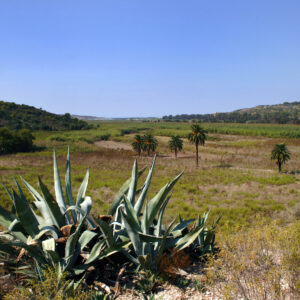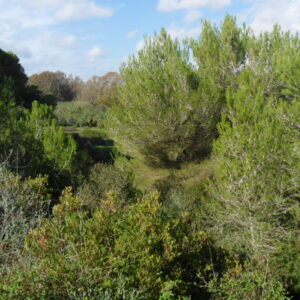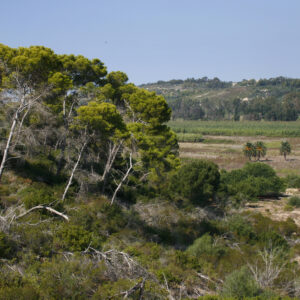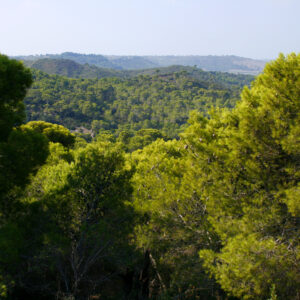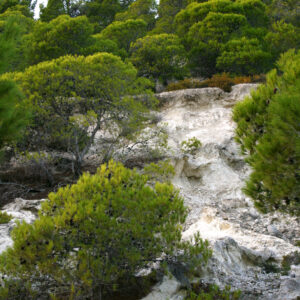Pino d'Aleppo
Pino d’Aleppo
Latitude and Longitude 36.933553022860984, 14.525369736711312
The protected area, pursuant to art. 7 of the L.R. 14/88, was identified as an Oriented Nature Reserve “in order to safeguard the last strips of native Pinus halepensis formation and to rebuild the pine forest in the garrigue area degraded by anthropic action”.
It was tipologically identified with D.A. 536/90; it falls within te municipalities of Ragusa, Vittoria and Comiso. With D.A. 536/90 the regulation containing the methods of use and prohibitions for bothzone A (reserve) and zone B ( pre-reserve) was approved. Its management has been entrusted to the Regional Province of Ragusa with D.A. n.352/89
It is therefore an area to be protected due to the environmental importance covered by the pine forest, probably of indigenous origin, which represents what remains of the plain forests of Santa Croce and Vittoria; in it the various interventions must be oriented in such a way as to favor the evolution of degraded ecosystems towards the reconstitution of the pine forest.
It is therefore an area to be protected due to the environmental importance covered by the pine forest, probably of indigenous origin, which represents what remains of the plain forests of Santa Croce and Vittoria; in it the various interventions must be oriented in such a way as to favor the evolution of degraded ecosystems towards the reconstitution of the pine forest.
In zone B (pre-reserve), cultural, agricultural and forestry interventions are allowed as long as they do not conflict with the conservation of the natural environment.
The Reserve has a good extension, about 3000 ha. Of these, about 850 ha in zone A, the remainder in zone B. Zone A is not represented by an entire nucleus but by a series of small areas surrounded by the pre-reserve (like a leopard spot).
The territory of the R.N.O. “Pino d’Aleppo” largely coincides with that of the SAC ITA080003 “Valley of the river Ippari (Pineta di Vittoria)” of the Natura 2000 Network, site identified under the Community Habitat Directive and extended to 2,691.94 ha.
The protected area has incorporated a territory, located along the Ippari valley, which since ancient times was suited for agricultural activities, especially for the presence of water, and therefore fits into an anthropized context; among other things, the Reserve touches the outskirts of the town of Vittoria.
The Ippari river is a small stream that slowly opens its way towards the sea in the last part. In the past, towards the mouth there was a marsh due to the stagnation of the waters. Even today, due to the morphology of the places, the river bed is often buried.
Leaving the town of Vittoria and heading towards S. Croce Camerina, on soils of whitish and soft rocks (Trubi), one encounters a particular vegetation consisting essentially of an undergrowth of Rosemary, Thyme and Lentisk that accompanies a particular pine forest, with a twisted and suffering posture: the Aleppo Pines (Pinus halepensis). Along the valley of the Ippari river, particularly in the most inaccessible areas, this species is not rare and constitutes a pine forest for which scholars have hypothesized an autochthonous and natural origin.
The Aleppo Pine, in its spontaneous state, has now disappeared from the rest of Sicily, only in this area located along the Ippari valley, it grows with a luxuriance, a disorder and a cortege of minor species which has allowed us to hypothesize that it represents a relic strip of the original forest that covered the territory in the past. From historical sources it is known, in fact, that in this area there was a dense and luxuriant forest, which until 1550 remained thick and shady. The undergrowth is represented by a rich scrub with thermophilic elements, including Oleastro and Carob (Ceratonia siliqua) and other species characteristic of the warmer Mediterranean climax: Oleo-Ceratonion.
More information on the reserves managed by the consortium can be found at this link.
Due to the agricultural activity and the tourist activities present, this protected area is subject to invasions by alien species.
Biological invasions by exotic species are considered to be one of the most relevant and significant causes of biodiversity loss and alteration of ecosystems on a global scale. These invasions can also be favored by the climate change taking place on our planet.
Within the Reserve, various alien species have been reported both among animal and plant species, as shown in table 2.
With the European Territorial Cooperation project – INTERREG V-A Italy Malta Program – FAST – cod. C2-3.1-121, as well as to raise awareness of the problems linked to the presence of alien species in a given territory, also protected and protected such as nature reserves, to carry out eradication demonstration interventions on alien species identified as Target (Saccarhum egyptiacum sp. spontaneum), subsequently preparing appropriate guidelines for intervention.


